We know about Toyota and how this organisation revolutionise the manufacturing world.
We know about KAIZEN (“good change”) and the importance of collaboration.
However, how many teams are telling you, “we cannot improve”, “we are already close to our limit”, “it’s not about us, it’s the system” … to justify their impossibility to improve?
Well, with this game you can show that there is always space for improvement, also in very simple activities like solving a puzzle for kids.
The game
This is not actually an hack of a game, but this is a different way to use an existing toy (jigsaw puzzle) together with an accessory that in practice is an improvement tracker.
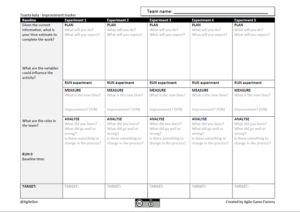
Here the link to download the PDF version of the tracker.
For these sessions I am using puzzle for kids.
In this link you can find a good example from Amazon, but you can find others everywhere.
Keep in mind to play the game you don’t need the frames, just the tiles.
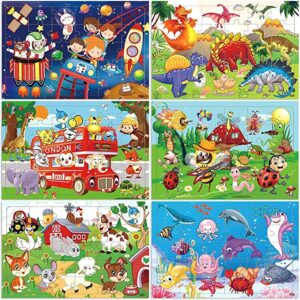
Why this is a good example?
- number of pieces is low (6×5=30)
- variants are very colourful and this will add a little bit of challenge to solving them
- many characters in the subject are better than few characters
- each character is distributed on few tiles
- wooden pieces are better that cardboard ones (but they can be easily broken and not bended)
- large pieces are better than small pieces
With above attributes you have a good and cheap solution of a challenge to be solved in few minutes for many many tries.
In fact the purpose of the game is to repeat and repeat, introducing improvements and measure their effects.
The opportunity to have many runs is more important than to have long runs.
Prepare the session
You need as many puzzles as the number of groups and this is the tricky part.
Not necessarily the same puzzle, but eventually this could add some competition and eventually cross fertilisation (see below)
You also need a copy of the improvement tracker for each of the teams.
Again you could eventually make it public on a whiteboard, this approach influence competitive spirit.
This is up to you if you think it could help or not.
In the room create a space for each of the groups.
Better to create isolated spaces, maybe using different tables.
All teams will play in parallel.
Run the session
Give to each of the teams a copy of the tracker.
For each of the groups, collect all of the tiles of their puzzle, mix them (like a deck of card) and put them face down in the middle of the table.
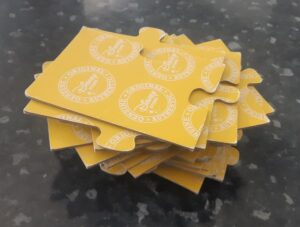
Now ask to teams to estimate the time to completely solve the puzzle.
Normally this is really open becasue they have no idea of the challenge: last time I was told numbers between 2 and 25 minutes (!!!)
This is a perfect moment to explore the cone of uncertainty (wikipedia link) and how this impacts on quality of estimation and how a “continuous estimation process” is a good practice against the “unique initial estimation”.
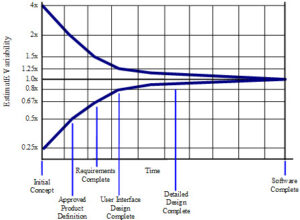
Give the team 2 minutes to find an agreed estimate and write it on the tracker.
After that give 3 minutes to the team to prepare themselves to solve the puzzle; one has to keep the time for his/her team.
Run the ROUND ZERO and measure the time.
As you can see in the tracker, you have 5 columns named experiment 1-5, in each of the experiment you have 5 stages:
- Plan: decide how to execute the experiment
- Run the experiment
- Measure the time required to solve the puzzle
- Analyse the time and the ways of working of the team, identifying what worked and what did not.
- Update, eventually, the target time
Each of these stages (except “Run the experiment”) must be timeboxed. Here is where your facilitation skills support the teams.
In my session normally I give 2′ for planning and 3 minutes for analysing the experiment and defining a new target.
Run and measure are in the same moment and required time is depending on the team performance.
What is difficult is to coordinate all groups that normally have a slightly different pace.
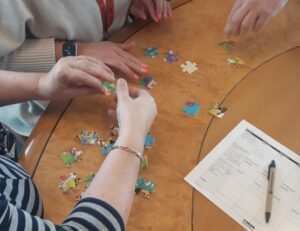
At the end of the experiment shuffle the tiles again and recreate the conditions for a new experiment.
All team decisions should be tracked on the the paper sheet, and eventually also if someone didn’t follow them. Clearly all success and failures should be recorded and it could be ok to update the target at the end of each experiment.
You can run as many experiments as you think it could be helpful, eventually you can use different pages of the tracker to record the data of each experiment, however after just 5 rounds normally few critical points very clear:
- The ways of working from round 0 and the following experiments is absolutely different
- The target time is radically lower than the initial estimate
- The mood in the team towards improving the performance is definitely more active
Now everyone has to bring the learning inside the their real teams, eventually playing the same game.
Other emerging topics
The performance of teams in this game are strongly related to the collaboration.
So you can use this session also to help teams in finding better ways to collaborate.
When you are playing with different groups you can introduce some moment of knowledge sharing.
These could happen as a presentation, or maybe with someone of the team A observing how team B is working.
This create a pure example of cross fertilisation, how knowledge could spread and move across an organisation
This game shows how teams find collaborative behaviours so that the can optimise their performance.
These behaviours could be very specific and maybe working just for them.
Eventually you could shuffle the teams after few rounds and see the effect of changing team composition; normally you can see performance initially decreasing and you can use this example to discuss about temporary (project based) teams vs stable (product based) teams.
Using a different toy
Here I have introduced this session using a jigsaw for kids but in reality you can follow the same model using different toys (or boardgames) and the tracker provided here.
Based on my experience, the requirements for the toy is that the activity should last enough to be measured and short enough to have many repetitions. Eventually it could have different stages (show, distribute, connect, check…) and maybe could be organised in roles. Another important requirement is that the activity should be replayable with the same level of uncertainty.
For example a typical puzzle game, once it is solved is very much easier to solve it again; instead a 30/50 pieces jigsaw has a similar solution time, so you can influence it challenging the process to solve it.
There is not a golden rule: IMHO the activity should take between 1 and 3 minutes, and give the opportunity to have a conversation about how to arrange the work in a different way.